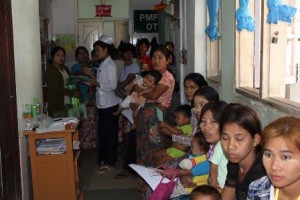A First for Surgicorps and a New Future for Ms. Huang Toe Toe
Mandalay, Myanmar
Story by Surgicorps volunteer Mario Guiterrez
It all started with a casual conversation over dinner during last year’s surgical mission to Paro, Bhutan between Surgicorps founder Dr. Jack Demos and one of the team’s surgeons, Debra Johnson. Dr. Johnson had, for more than twelve years, led volunteer surgical missions to Myanmar (formerly Burma). However, these missions sadly came to an end in 2002 due to lack of organizational funding support and increased political tensions between the US and Myanmar. All it took was for Dr. Jack to ask, “Any chance you think we can initiate a Surgicorps mission there?” for Debra to send off a flurry of emails to her contacts in Mandalay, Myanmar to explore the possibilities.
As a young resident Dr. Nu Nu Yee, had been mentored by Dr. Johnson during her many visits to Yangon (the Capital) General Hospital. Now Dr. Yee was the Chief of Plastic Surgery at Mandalay General Hospital. Upon hearing of Surgicorps and Dr. Johnson’s desire to work at her hospital, Dr. Yee and our Executive Director Linda Esposto worked diligently together to obtain all the necessary approvals from the Ministry of Health and secure the visas for the team. Finally, with all in place, the inaugural Surgicorps volunteer mission was set for February, 2013.
Myanmar is a fairly large, and relatively poor country that until recently had been isolated from the rest of the world. It has a population of 65 million — but with only five surgeons trained in plastic reconstructive surgery. Consequently, the number of children born with congenital defects such as cleft lip and palate, have greatly outstripped the capacity of Dr. Nu Nu Yee and her colleagues in Yangon to meet the overwhelming demand for care. The Surgicorps Mandalay team, was led by Dr. Jack Demos, and included two other surgeons Dr. Johnson and Dr. David Kim from Boston. On the first day clinic the team screened over 100 children and young adults who were in need of surgery And, while they included the usual array of cleft lip, palates, and burn contractures, there was one young lady that stood out from the rest.
Ms. Huang Toe Toe was 21 years of age, who, at first glance seemed to be a normal, attractive young woman with a warm, ready smile typical of the Burmese people. However, upon glancing down at her feet we could not believe our eyes. Miss Toe Toe (her family name oddly enough) had one normal foot and another that appeared to be round and about the size of a basketball, with large grotesquely malformed toes. This rare condition was the result of a genetic disorder. When the news came to her that a team of surgeons would be coming from the US to Mandalay to provide free surgical care, she and her family traveled for several days from their remote village with the hope that something could be done to alleviate this burdensome foot deformity. Her surgeon, Dr. David Kim, did not feel the foot could be salvaged, and thought Ms. Toe Toe’s best option for treatment would be a below knee amputation, surgery set for three days later. Since they were far from home and had little money, she and her family remained in Mandalay in a makeshift camp on the hospital grounds.
As I observed her walking around over the course of the three days, it was remarkable to see how well this young woman had adapted to her over-sized, foot-like appendage. The day after her surgery, I interviewed her and her family through an interpreter in the post-op ward. I asked her what it was like to have lived her entire life with this unusual foot. She responded that within her village everyone accepted it as a part of her, but when she ventured out she felt ashamed and was the subject of peer ridicule. I then asked her to tell me how it felt to finally be free of her unusually large foot. She thought for a minute and then told me that while she was very happy and grateful to no longer have this incredible burden, it was still difficult for her to adjust to the idea that it was really gone. After all, it had been part of her since birth, and she was worried that without it she would not be able to walk again.
We explained that our team pediatrician had arranged with the hospital staff for her to travel to Yangon in a few weeks, where she would undergo physical therapy and be fitted with prosthesis and eventually be able to walk normally. Her eyes brightened at the thought. She told me with tears in her eyes that she never thought that it would be possible for her to ever lead a normal life. And now thanks to our efforts, she would be able to fulfill her lifelong dreams of being able to ride a bicycle, wear pretty slip-ons like the other Burmese women, and maybe someday fall in love, get married and have children.
A truly remarkable story and a life forever changed as a result of our medical volunteers and the generosity of Surgicorps supporters. For more images from Myanmar, please visit us on Facebook.




